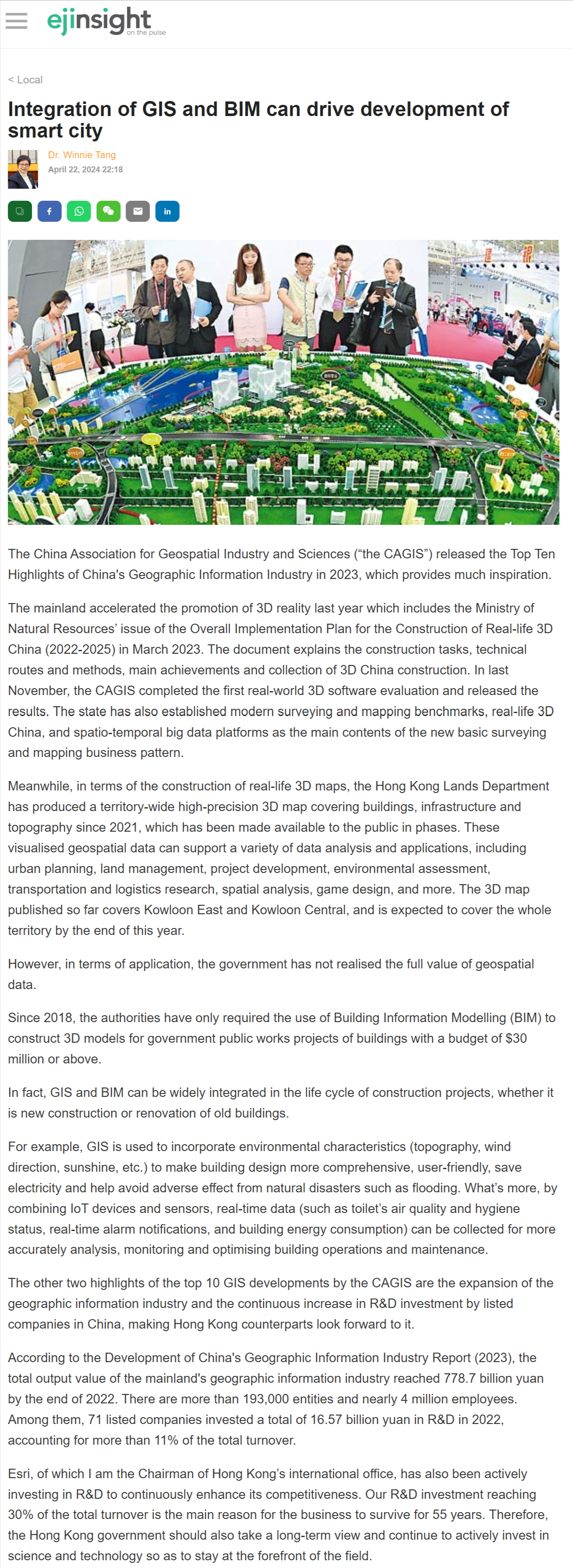網上版請按此

Integration of GIS and BIM can drive development of smart city
The China Association for Geospatial Industry and Sciences ("the CAGIS") released the Top Ten Highlights of China's Geographic Information Industry in 2023, which provides much inspiration.
The mainland accelerated the promotion of 3D reality last year which includes the Ministry of Natural Resources' issue of the Overall Implementation Plan for the Construction of Real-life 3D China (2022-2025) in March 2023. The document explains the construction tasks, technical routes and methods, main achievements and collection of 3D China construction. In last November, the CAGIS completed the first real-world 3D software evaluation and released the results. The state has also established modern surveying and mapping benchmarks, real-life 3D China, and spatio-temporal big data platforms as the main contents of the new basic surveying and mapping business pattern.
Meanwhile, in terms of the construction of real-life 3D maps, the Hong Kong Lands Department has produced a territory-wide high-precision 3D map covering buildings, infrastructure and topography since 2021, which has been made available to the public in phases. These visualised geospatial data can support a variety of data analysis and applications, including urban planning, land management, project development, environmental assessment, transportation and logistics research, spatial analysis, game design, and more. The 3D map published so far covers Kowloon East and Kowloon Central, and is expected to cover the whole territory by the end of this year.
However, in terms of application, the government has not realised the full value of geospatial data.
Since 2018, the authorities have only required the use of Building Information Modelling (BIM) to construct 3D models for government public works projects of buildings with a budget of $30 million or above.
In fact, GIS and BIM can be widely integrated in the life cycle of construction projects, whether it is new construction or renovation of old buildings.
For example, GIS is used to incorporate environmental characteristics (topography, wind direction, sunshine, etc.) to make building design more comprehensive, user-friendly, save electricity and help avoid adverse effect from natural disasters such as flooding. What's more, by combining IoT devices and sensors, real-time data (such as toilet's air quality and hygiene status, real-time alarm notifications, and building energy consumption) can be collected for more accurately analysis, monitoring and optimising building operations and maintenance.
The other two highlights of the top 10 GIS developments by the CAGIS are the expansion of the geographic information industry and the continuous increase in R&D investment by listed companies in China, making Hong Kong counterparts look forward to it.
According to the Development of China's Geographic Information Industry Report (2023), the total output value of the mainland's geographic information industry reached 778.7 billion yuan by the end of 2022. There are more than 193,000 entities and nearly 4 million employees. Among them, 71 listed companies invested a total of 16.57 billion yuan in R&D in 2022, accounting for more than 11% of the total turnover.
Esri, of which I am the Chairman of Hong Kong's international office, has also been actively investing in R&D to continuously enhance its competitiveness. Our R&D investment reaching 30% of the total turnover is the main reason for the business to survive for 55 years. Therefore, the Hong Kong government should also take a long-term view and continue to actively invest in science and technology so as to stay at the forefront of the field.
Dr. Winnie Tang
Adjunct Professor, Department of Computer Science, Faculty of Engineering; Department of Geography, Faculty of Social Sciences; and Faculty of Architecture, The University of Hong Kong